ESP Citroen DS4 2017 1.G Repair Manual
[x] Cancel search | Manufacturer: CITROEN, Model Year: 2017, Model line: DS4, Model: Citroen DS4 2017 1.GPages: 421, PDF Size: 8.79 MB
Page 287 of 421
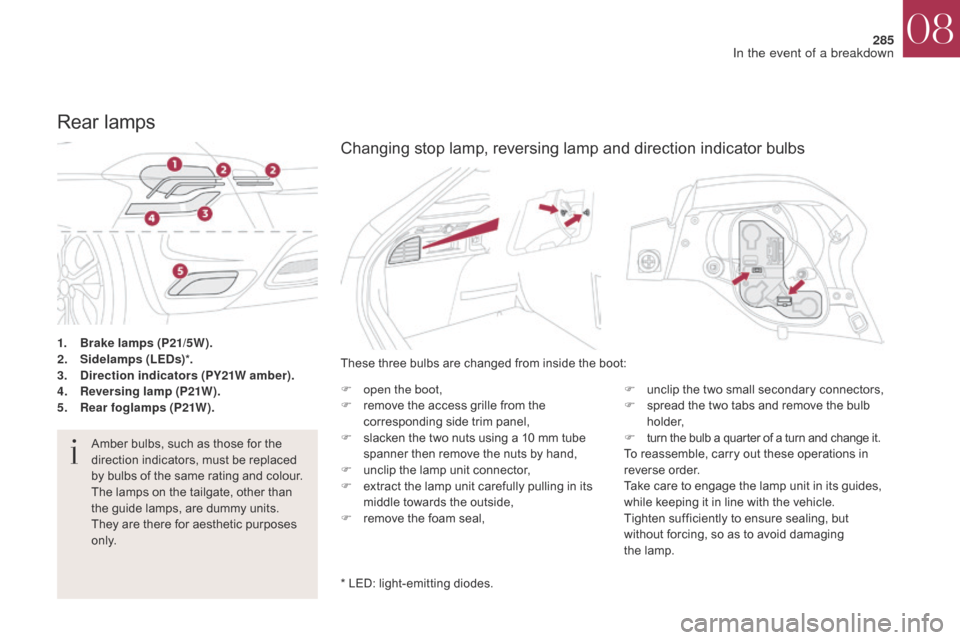
285
DS4_en_Chap08_en-cas-de-panne_ed01-2016
1. Brake lamps (P21/5W).
2. Sidelamps (LEDs) *.
3.
D
irection indicators (PY21W amber).
4.
R
eversing lamp (P21W).
5.
R
ear foglamps (P21W).
Rear lamps
Amber bulbs, such as those for the
direction indicators, must be replaced
by bulbs of the same rating and colour.
The lamps on the tailgate, other than
the guide lamps, are dummy units.
They are there for aesthetic purposes
o n l y. These three bulbs are changed from inside the boot:
F
o
pen the boot,
F
r
emove the access grille from the
corresponding side trim panel,
F s lacken the two nuts using a 10 mm tube
spanner then remove the nuts by hand,
F
u
nclip the lamp unit connector,
F
e
xtract the lamp unit carefully pulling in its
middle towards the outside,
F
r
emove the foam seal,F
u
nclip the two small secondary connectors,
F
s
pread the two tabs and remove the bulb
h o l d e r,
F t urn the bulb a quarter of a turn and change it.
To reassemble, carry out these operations in
reverse order.
Take care to engage the lamp unit in its guides,
while keeping it in line with the vehicle.
Tighten sufficiently to ensure sealing, but
without forcing, so as to avoid damaging
the
lamp.
* LED: light-emitting diodes.
Changing stop lamp, reversing lamp and direction indicator bulbs
08
In the event of a breakdown
Page 291 of 421
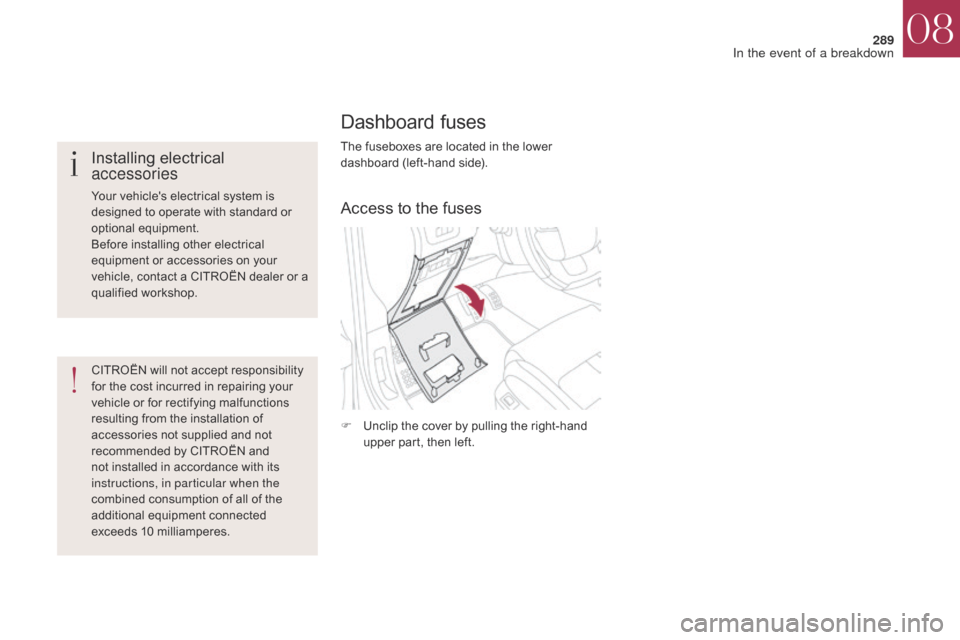
289
DS4_en_Chap08_en-cas-de-panne_ed01-2016
Dashboard fuses
The fuseboxes are located in the lower
dashboard (left-hand side).
F
U
nclip the cover by pulling the right-hand
upper part, then left.Installing electrical
accessories
Your vehicle's electrical system is
designed to operate with standard or
optional equipment.
Before installing other electrical
equipment or accessories on your
vehicle, contact a CITROËN dealer or a
qualified workshop.
CITROËN will not accept responsibility
for the cost incurred in repairing your
vehicle or for rectifying malfunctions
resulting from the installation of
accessories not supplied and not
recommended by CITROËN and
not installed in accordance with its
instructions, in particular when the
combined consumption of all of the
additional equipment connected
exceeds 10 milliamperes.Access to the fuses
08
In the event of a breakdown
Page 297 of 421
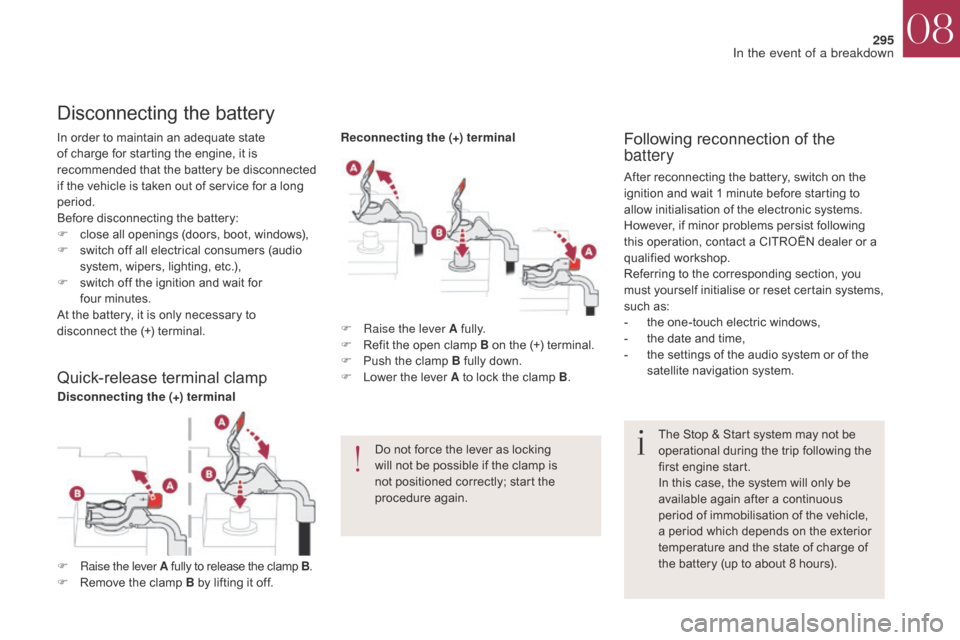
295
DS4_en_Chap08_en-cas-de-panne_ed01-2016
In order to maintain an adequate state
of charge for starting the engine, it is
recommended that the battery be disconnected
if the vehicle is taken out of service for a long
period.
Before disconnecting the battery:
F
c
lose all openings (doors, boot, windows),
F
s
witch off all electrical consumers (audio
system, wipers, lighting, etc.),
F
s
witch off the ignition and wait for
four
m
inutes.
At the battery, it is only necessary to
disconnect the (+) terminal.
Disconnecting the battery
The Stop & Start system may not be
operational during the trip following the
first engine start.
In this case, the system will only be
available again after a continuous
period of immobilisation of the vehicle,
a period which depends on the exterior
temperature and the state of charge of
the battery (up to about 8 hours).
F
Ra
ise the lever A fully.
F
R
efit the open clamp B on the (+) terminal.
F
P
ush the clamp B fully down.
F
L
ower the lever A to lock the clamp B
.
Do not force the lever as locking
will not be possible if the clamp is
not positioned correctly; start the
procedure again.
Following reconnection of the
battery
After reconnecting the battery, switch on the
ignition and wait 1 minute before starting to
allow initialisation of the electronic systems.
However, if minor problems persist following
this operation, contact a CITROËN dealer or a
qualified workshop.
Referring to the corresponding section, you
must yourself initialise or reset certain systems,
such as:
-
t
he one-touch electric windows,
-
t
he date and time,
-
t
he settings of the audio system or of the
satellite navigation system.
Quick-release terminal clamp
F Raise the lever A fully to release the clamp B .
F R emove the clamp B by lifting it off.
Disconnecting the (+) terminal Reconnecting the (+) terminal
08
In the event of a breakdown
Page 300 of 421
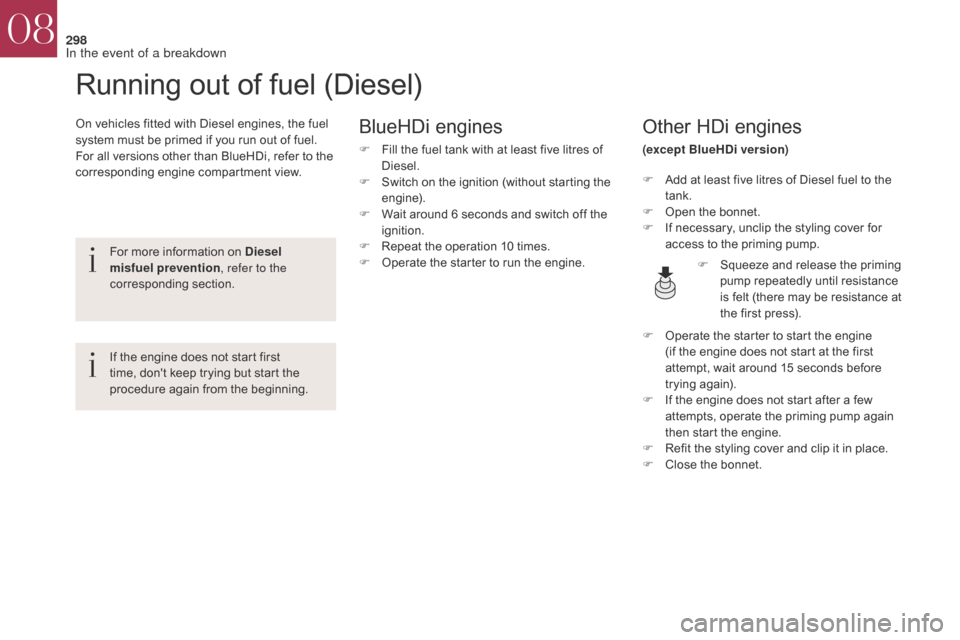
298
DS4_en_Chap08_en-cas-de-panne_ed01-2016
Running out of fuel (Diesel)
On vehicles fitted with Diesel engines, the fuel
system must be primed if you run out of fuel.
For all versions other than BlueHDi, refer to the
corresponding engine compartment view.Other HDi engines
(except BlueHDi version)
For more information on Diesel
misfuel prevention , refer to the
corresponding section.
If the engine does not start first
time, don't keep trying but start the
procedure again from the beginning. F
A
dd at least five litres of Diesel fuel to the
tank.
F
O
pen the bonnet.
F
I
f necessary, unclip the styling cover for
access to the priming pump.
F
S
queeze and release the priming
pump repeatedly until resistance
is felt (there may be resistance at
the first press).
F
O
perate the starter to start the engine
(if the engine does not start at the first
attempt, wait around 15 seconds before
trying again).
F
I
f the engine does not start after a few
attempts, operate the priming pump again
then start the engine.
F
R
efit the styling cover and clip it in place.
F
C
lose the bonnet.
BlueHDi engines
F Fill the fuel tank with at least five litres of Diesel.
F
S
witch on the ignition (without starting the
engine).
F
W
ait around 6 seconds and switch off the
ignition.
F
R
epeat the operation 10 times.
F
O
perate the starter to run the engine.
08
In the event of a breakdown
Page 304 of 421
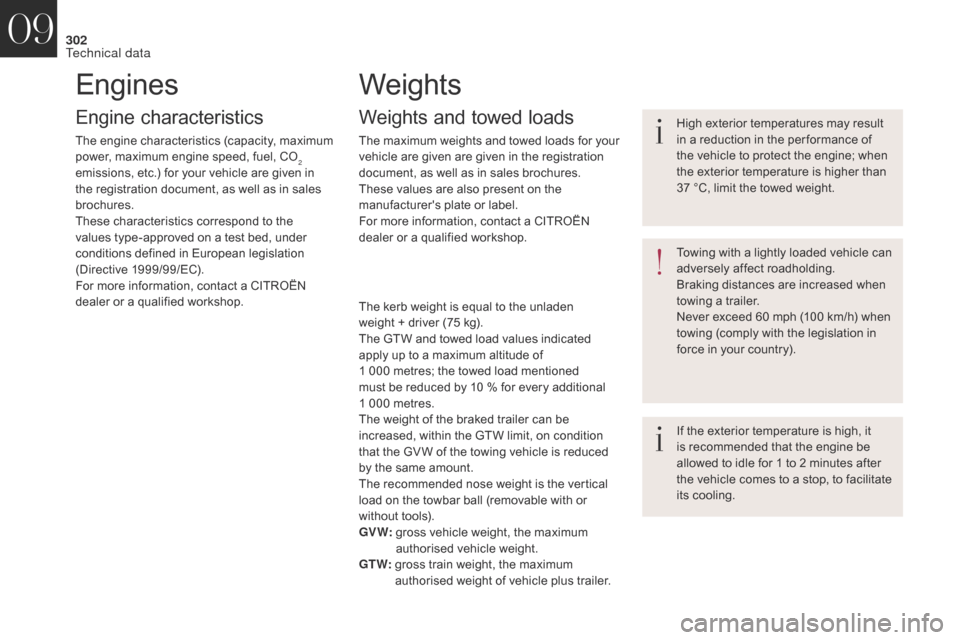
302
DS4_en_Chap09_caracteristiques_ed01-2016
Engines
Engine characteristics
The engine characteristics (capacity, maximum
power, maximum engine speed, fuel, CO
2
emissions, etc.) for your vehicle are given in
the registration document, as well as in sales
brochures.
These characteristics correspond to the
values type-approved on a test bed, under
conditions defined in European legislation
(Directive
1
999/99/EC).
For more information, contact a CITROËN
dealer or a qualified workshop.
Weights
Weights and towed loads
The maximum weights and towed loads for your
vehicle are given are given in the registration
document, as well as in sales brochures.
These values are also present on the
manufacturer's plate or label.
For more information, contact a CITROËN
dealer or a qualified workshop.
The kerb weight is equal to the unladen
weight
+ driver (75 kg).
The GTW and towed load values indicated
apply up to a maximum altitude of
1
000 metres; the towed load mentioned
must be reduced by 10 % for every additional
1
000 metres.
The weight of the braked trailer can be
increased, within the GTW limit, on condition
that the GV W of the towing vehicle is reduced
by the same amount.
The recommended nose weight is the vertical
load on the towbar ball (removable with or
without tools).
GV W:
g
ross vehicle weight, the maximum
authorised vehicle weight.
GT W:
g
ross train weight, the maximum
authorised weight of vehicle plus trailer. High exterior temperatures may result
in a reduction in the per formance of
the vehicle to protect the engine; when
the exterior temperature is higher than
37
°C, limit the towed weight.
If the exterior temperature is high, it
is recommended that the engine be
allowed to idle for 1 to 2 minutes after
the vehicle comes to a stop, to facilitate
its cooling. Towing with a lightly loaded vehicle can
adversely affect roadholding.
Braking distances are increased when
towing a trailer.
Never exceed 60 mph (100 km/h) when
towing (comply with the legislation in
force in your country).
09
Technical data
Page 305 of 421
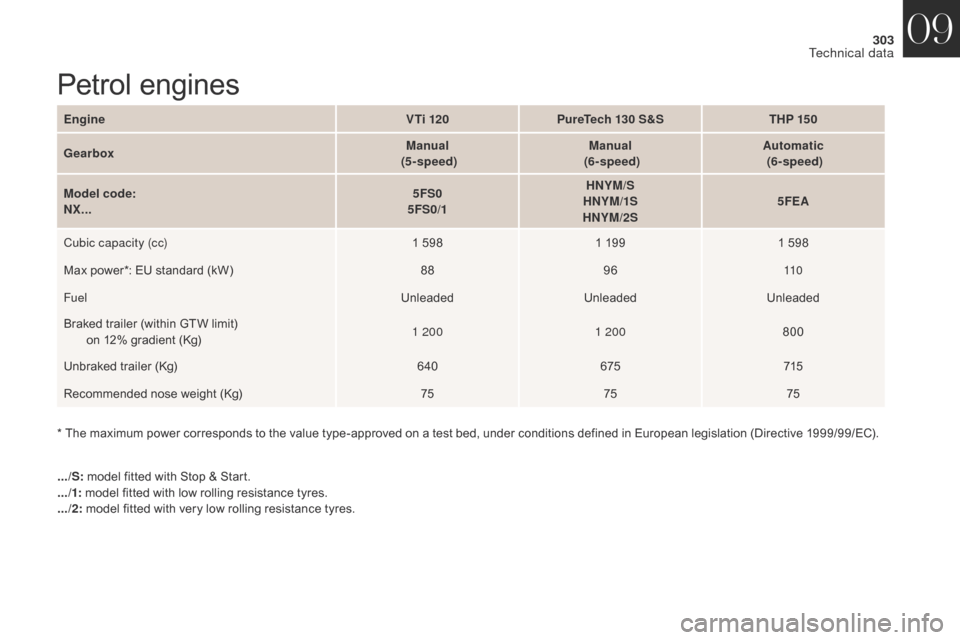
303
DS4_en_Chap09_caracteristiques_ed01-2016
Petrol engines
.../S: model fitted with Stop & Start.
.../1: model fitted with low rolling resistance tyres.
.../2: model fitted with very low rolling resistance tyres.
*
The maximum power corresponds to the value type-approved on a test bed, under conditions defined in European legislation (Directive 1999/99/EC).
Engine
V Ti 120PureTech 130 S&S THP 15 0
Gearbox Manual
(5 - speed) Manual
(6- speed) Automatic
(6- speed)
Model code:
NX... 5FS0
5FS0/1 HNYM/S
HNYM/1S
HNYM/2S 5FEA
Cubic capacity (cc) 1 5981 1991 598
Max power*: EU standard (kW) 889611 0
Fuel UnleadedUnleadedUnleaded
Braked trailer (within GTW limit)
o
n 12% gradient (Kg)
1 200
1 200 800
Unbraked trailer (Kg) 640675715
Recommended nose weight (Kg) 757575
09
Technical data
Page 306 of 421
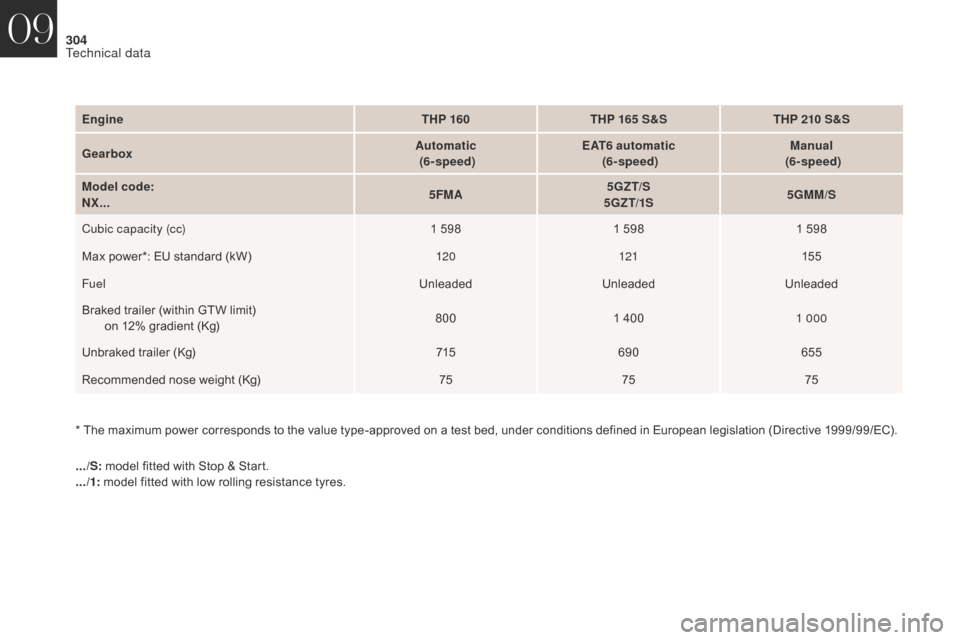
304
DS4_en_Chap09_caracteristiques_ed01-2016
.../S: model fitted with Stop & Start.
.../1: model fitted with low rolling resistance tyres.
*
T
he maximum power corresponds to the value type-approved on a test bed, under conditions defined in European legislation (Directive 1999/99/EC).
Engine
THP 160THP 165 S&S THP 210 S&S
Gearbox Automatic
(6- speed) EAT6 automatic
(6- speed) Manual
(6- speed)
Model code:
NX... 5FMA5GZT/S
5GZ T/1S 5GMM/S
Cubic capacity (cc) 1 5981 5981 598
Max power*: EU standard (kW) 120121155
Fuel UnleadedUnleadedUnleaded
Braked trailer (within GTW limit)
o
n 12% gradient (Kg)
800
1 400 1 000
Unbraked trailer (Kg) 715690 655
Recommended nose weight (Kg) 757575
09
Technical data
Page 307 of 421
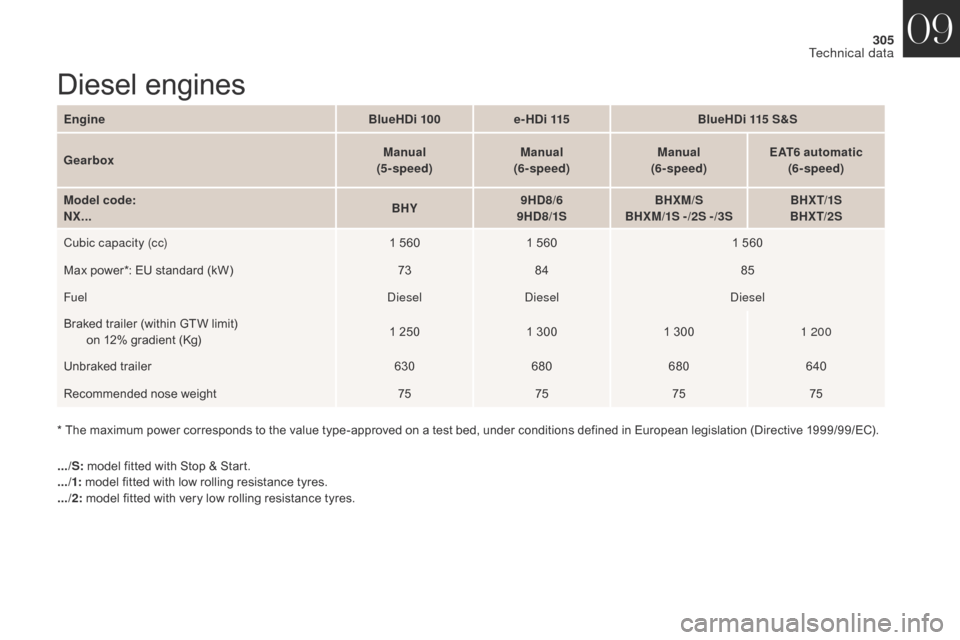
305
DS4_en_Chap09_caracteristiques_ed01-2016
Diesel engines
.../S: model fitted with Stop & Start.
.../1: model fitted with low rolling resistance tyres.
.../2: model fitted with very low rolling resistance tyres.
*
T
he maximum power corresponds to the value type-approved on a test bed, under conditions defined in European legislation (Directive 1999/99/EC).
Engine
BlueHDi 100e-HDi 115 BlueHDi 115 S&S
Gearbox Manual
(5 - speed) Manual
(6- speed) Manual
(6- speed) EAT6 automatic
(6- speed)
Model code:
NX... BHY9HD8/6
9HD8 /1S BHXM/S
BHXM/1S -/2S -/3S BHX T/1S
BHX T/2S
Cubic capacity (cc) 1 5601 560 1 560
Max power*: EU standard (kW) 7384 85
Fuel DieselDiesel Diesel
Braked trailer (within GTW limit)
o
n 12% gradient (Kg)
1 250
1 300 1 300 1 200
Unbraked trailer 630680 680640
Recommended nose weight 75757575
09
Technical data
Page 308 of 421
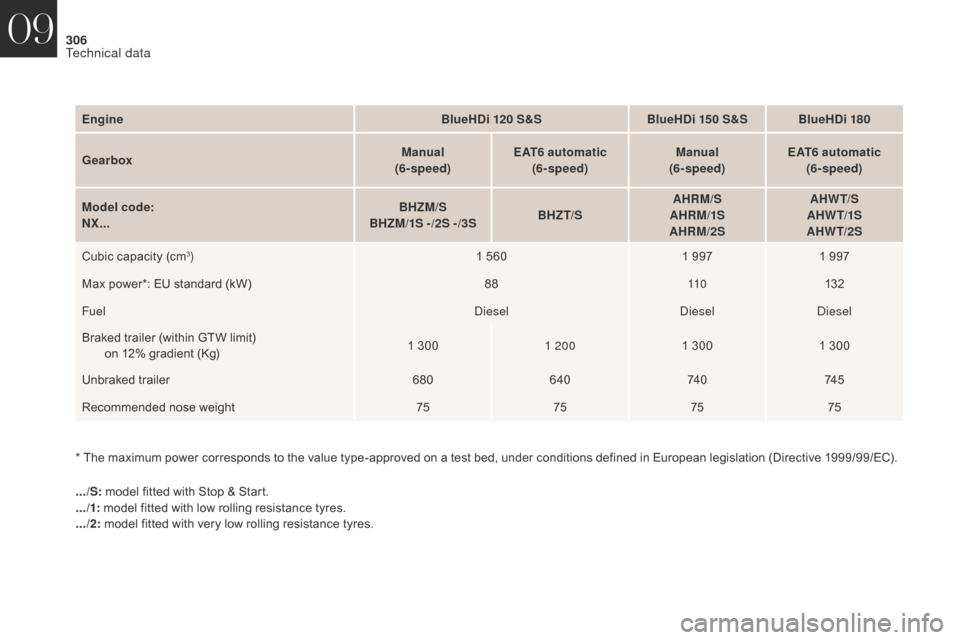
306
DS4_en_Chap09_caracteristiques_ed01-2016
* The maximum power corresponds to the value type-approved on a test bed, under conditions defined in European legislation (Directive 1999/99/EC).
.../S: model fitted with Stop & Start.
.../1: model fitted with low rolling resistance tyres.
.../2: model fitted with very low rolling resistance tyres.
Engine
BlueHDi 120 S&SBlueHDi 150 S&S BlueHDi 180
Gearbox Manual
(6- speed) EAT6 automatic
(6- speed) Manual
(6- speed) EAT6 automatic
(6- speed)
Model code:
NX... BHZM/S
BHZM/1S -/2S -/3S BHZT/SAHRM/S
AHRM/1S
AHRM/2S AHW T/S
AHW T/1S
AHW T/2S
Cubic capacity (cm
3) 1 5601 9971 997
Max power*: EU standard (kW) 8811 0132
Fuel DieselDieselDiesel
Braked trailer (within GTW limit)
o
n 12% gradient (Kg) 1 300
1 2001 300 1 300
Unbraked trailer 680640 74 074 5
Recommended nose weight 75757575
09
Technical data
Page 341 of 421
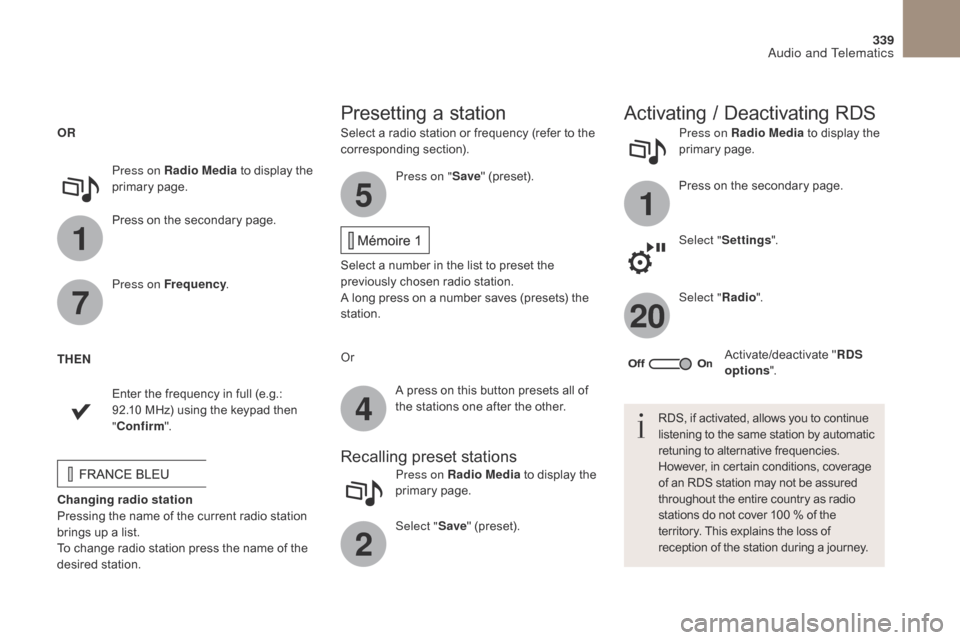
1
1
20
5
4
2
7
339
DS4_en_Chap10b_SMEGplus_ed01-2016
Select a radio station or frequency (refer to the
corresponding section).Press on Radio Media
to display the
primary page.
Press on the secondary page.
Select " Settings ".
Select " Radio".
Activate/deactivate " RDS
options ".
Press on Radio Media
to display the
primary page.
Press on the secondary page. Press on "
Save" (preset).
Select a number in the list to preset the
previously chosen radio station.
A long press on a number saves (presets) the
station.
Press on Frequency
.
Enter the frequency in full (e.g.:
92.10 MHz) using the keypad then
" Confirm ".
Changing radio station
Pressing the name of the current radio station
brings up a list.
To change radio station press the name of the
desired station. Or
Press on Radio Media to display the
primary page.
Select " Save" (preset).
Presetting a station Activating / Deactivating RDS
OR
THEN
A press on this button presets all of
the stations one after the other.
Recalling preset stations
RDS, if activated, allows you to continue
listening to the same station by automatic
retuning to alternative frequencies.
However, in certain conditions, coverage
of an RDS station may not be assured
throughout the entire country as radio
stations do not cover 100 % of the
territory. This explains the loss of
reception of the station during a journey.
Audio and Telematics